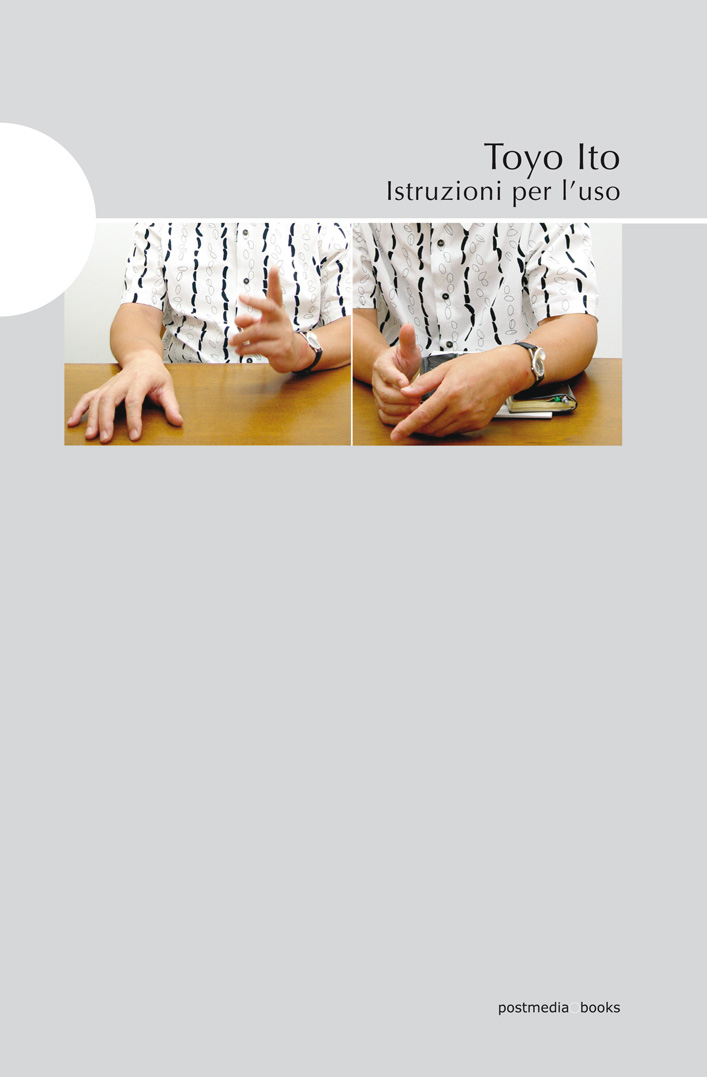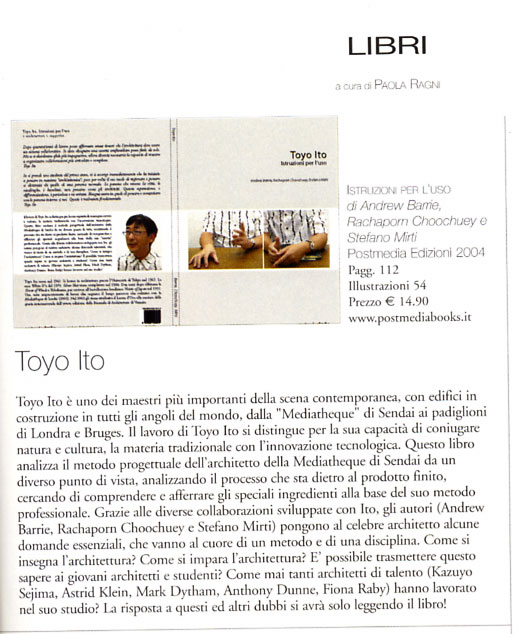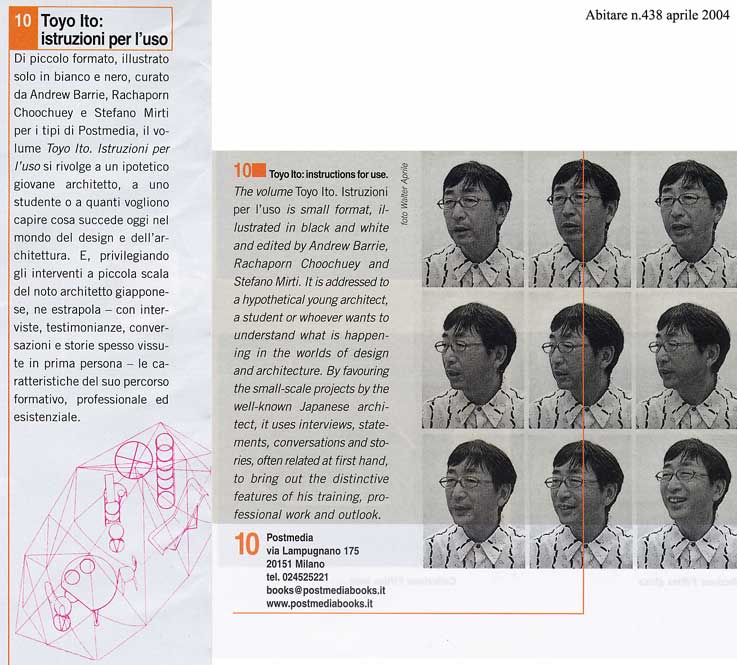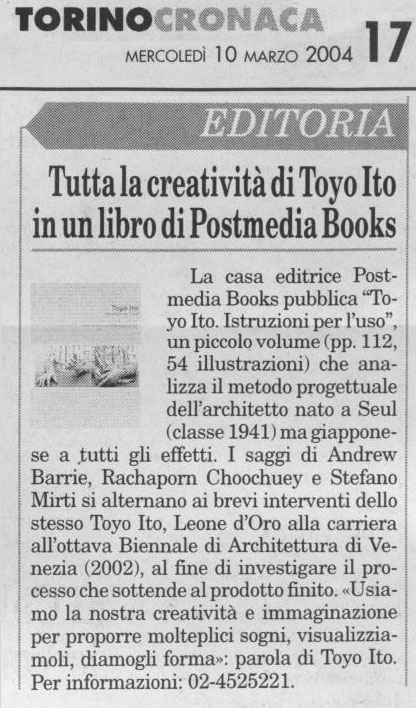| |
|
 |
Giampiero Bosoni / Domus 873 / 09/2004
Per chi ha incontrato almeno una volta Toyo Ito a una conferenza o in altre occasioni, può risultare facile ricollegare la curiosa fantasia della camicia che si vede indosso al protagonista della sequenza fotografica al nostro personaggio in questione, il celebre architetto giapponese del quale si intende offrire in questo volumetto delle vere e proprie ”istruzioni per l’uso”.
Una prima parte, Tokyo: Imparare > Insegnare, comprende una introduzione che porta il titolo del libro e propone per punti il taglio critico di lettura: un testo con delle posizioni abbastanza militanti, forse espresse in una chiave un po’ troppo giovanilistica, ma certamente interessanti. Segue una lunga e coinvolgente intervista a Toyo Ito fatta insieme da tutti e tre i curatori. Poi si passa ad alcune simpatiche interviste fatte a giovani architetti (Mark Dytham, Fiona Raby) che hanno lavorato con Ito e in seguito hanno intrapreso delle promettenti esperienze professionali.
Si aggancia a questa serie di testimonianze anche un contributo di Andrew Barrie. Il titolo di quest’ultimo intervento, Una Porsche viola e un furgoncino Honda, ci vuole sottolineare la originalità di Toyo Ito (che per alcuni potrà sembrare una vera e propria stravaganza) di possedere una Porsche di colore viola. Per rendere più intrigante questa osservazione, in una nota a parte ci viene ricordato che anche il geniale ed estroverso architetto italiano Mollino possedeva una Porsche, nel suo caso di colore giallo, e da ciò scaturisce alla fine la considerazione che “A volte, i dettagli apparentemente inaspettati sono quelli che ci permettono di capire delle cose”. Questa prima parte si conclude con un testo teorico di Toyo Ito del 1995 (pubblicato in Kenchiku Zasshi, Tokyo), sicuramente un passaggio chiave del libro, intitolato L’immagine dell’architettura nell’era dell’elettronica. Senza dubbio sono i testi originali di Ito (fra i quali comprendiamo la bella e articolata intervista fatta dai curatori) i documenti di maggiore interesse per conoscere direttamente l’affascinante visione del mondo contemporaneo e prossimo venturo proposta da Ito.
A questo punto si passa alla seconda parte del volumetto intitolata Bangkok: Insegnare > Imparare. Questa parte è molto più breve della prima ed è dedicata integralmente alla particolare esperienza di un workshop voluto da Ito, intitolato “Tomorrow Where Shall We Live?”, e tenutosi a Bangkok nel 1996. Oltre alla storia di come si è concepito e organizzato questo laboratorio di progetto si propongono due brevi testi teorico-divulgativi scritti da Ito (Un messaggio per il XXI secolo, Tarzan nella foresta dei medi), il primo scritto come introduzione al lavoro del Workshop e il secondo come suo testo conclusivo di questa ricerca. Si accompagnano anche i testi e le immagini di quattro progetti realizzati da alcuni giovani partecipanti a questo laboratorio.
Il libro si chiude con una curiosa bibliografia ragionata curata da Stefano Mirti dal titolo Da Lao Tzu a Sailor Moon. Qualche lettura per capire Ito e il pianeta Giappone. Si tratta di una stimolante proposta di lettura trasversale e quasi accidentale che ci porta come dice lo stesso Mirti “da Sun Tzu alla Sony, come se fosse un ottovolante”, dove non è dato sapere se il giro della morte (inteso come l’effetto di maggiore trascendenza) sia il libro proposto come prima chiave di lettura, L’uomo nell’alto castello di Philip K. Dick, oppure l’introduzione di Carl Jung al libro dei Ching, o ancora Lo zen e il tiro con l’arco di Harrigel. Sin qui in sintesi i vari contenuti di questo pratico strumento di lettura e di approfondimento del pensiero progettuale di Toyo Ito.
Ma vediamo più da vicino quali sono queste tracce interpretative, che i curatori offrono come “istruzioni per l’uso” del modo di concepire e di progettare di Ito. Perché, bisogna precisare, che proprio come di uno strumento pratico, capace di portare il lettore, soprattutto giovane architetto, ad “imparare dal maestro”, si parla di questo libretto nell’introduzione scritta da Choochuey e Mirti.
Innanzitutto la scelta dei curatori è quella di concentrarsi sull’analisi dei progetti di piccole dimensioni realizzati da Ito. Questa scelta viene proposta come una formula di avvicinamento al suo lavoro che in queste occasioni dimostra una grande tensione progettuale (non minore di quella che lui investe in progetti di grandi dimensioni), ma che si applica su scale di intervento che, secondo i curatori, potrebbero dirsi alla portata anche di giovani progettisti.
In tal senso i curatori suggeriscono di utilizzare questa serie di piccoli lavori di ricerca di Ito come una sorta di “bussole concettuali (…) di tipo speciale, che ci permettono di guardare dove sta andando Ito, dove sta andando l’architettura, dove vogliamo collocarci rispetto al dibattito corrente, quale posizione vogliamo tenere (se ne abbiamo la forza e la capacità)”. A questo punto vengono proposte in successione le “istruzioni per l’uso” che sono precisamente quattro. La prima dice: il concetto deriva dal racconto. La seconda istruzione afferma: la forma deriva dal concetto. La terza precisa: la tecnologia deriva dalla forma. La quarta e ultima istruzione conclude: il racconto deriva dalla tecnologia.
Come ci tengono a sottolineare gli estensori di queste ‘istruzioni’, si presenta alla fine una sorta di circolarità, che noi aggiungiamo è tipica di alcuni aforismi del pensiero Zen. Ci pare di capire che il senso di queste istruzioni sia quello di ricordare soprattutto ai giovani, ma anche ai progettisti meno giovani, che fare architettura non deve significare solo fare costruzioni funzionali, ma piuttosto deve significare costruire “storie affascinanti, che ci prendano al cuore e alla gola, – scrivono i curatori – usando i materiali fisici (e non fisici) dell’architettura per esprimere le nostre idee, le nostre visioni, le nostre idee più nascoste”.
Questi argomenti sono tutti molto belli e giusti, ma attenzione a non propugnarli come facili “istruzioni per l’uso”, altrimenti, a nostro avviso, si rischia di incedere in una pericolosa forma di mistificazione, che fa perdere di vista, soprattutto ai giovani progettisti, quanto gli stessi curatori si preoccupano di ricordare verso la fine della loro introduzione (guarda caso parlando della quarta istruzione: il racconto deriva dalla tecnologia), che “forse è il caso di ripetere un concetto mai abbastanza ripetuto: qualsiasi attività progettuale è all’1% ispirazione, lasciando il restante 99% in termini di traspirazione”. Basta leggere la piacevole intervista ad Ito per capire che solo una grande passione, una solida formazione, un duro tirocinio, un continuo impegno, possono costituire quella palestra intellettuale e professionale grazie alla quale le buone idee, le storie affascinanti, possono diventare realtà.
Giampiero Bosoni Professore di Architettura degli interni al Politecnico di Milano
|
| |
Paola Ragni / Casa Mia Decor / 06/2004

|
| |
Abitare / 04/2004

|
| |
A. Allegretti / Torino Cronaca / 03/2004

|
| |
Pedro Pablo Arroyo Alba / Arch'IT / 04/2004
Much has been written about Toyo Ito's work. One of his recent projects, the mediatheque in Sendai has been one of the most expected architectural events in recent years. As the authors notice, it was the most published project in 2001, and has received all the design prizes that any architect can dream of, inside and outside Japan.
However, Istruzioni per l'uso offers a new approach. The book almost does not talk about the mediatheque. It neither presents the latest and large commissions that are transforming Toyo Ito into an international trademark. Andrew, Racha and Stefano are not so interested in the final results of Ito's architecture, but rather in the working process that leads to those results, independently of the architectural scale. Indeed, because they mostly analyze Ito's small size projects, always present in his production, we can identify ourselves with the Japanese architect. By analyzing the abstract designing machinery behind Ito's houses, pavilions, interiors, installations, etc., the book is very useful for the reader, being this architect or student, and has high didactic value. It's not casual that the authors combine their professional careers with academic positions. Furthermore, they have developed their activities in Tokyo for some years, therefore this unique book benefits and manifests their profound knowledge about Toyo Ito's work.
Among others writings by the architect, the book contains Ito's article "The Image of Architecture in the Electronic Age". The second paragraph is titled "Architecture in the electronic age is a extended form of media suit". As Ito also mentions, this statement is a clear reference to Marshall McLuhan's theories of technological determinism, in which the Canadian author explains how different technologies imply extensions of the human body and subsequent effects in the society. "People clad in a media suit have their brain expanded", says Toyo Ito. In the essay the medium is the message McLuhan proceeded: the content of any media is another media: speech is the content of writing, as writing is the content of print, and the printed word is the content of the telegraph…the content of the speech is the process of thought, which is non verbal…
Consciously or not, but very efficiently explained in any case, Andrew, Racha and Stefano depict in Toyo Ito's model a similar procedural mechanism. Using the words of the authors, "the building is not the purpose, but rather the tool for telling a story that fills our minds". Ito is able of providing for new stories, compelling, fascinating and convincing stories. Clear characters, clear plot, simple stories, these are the type of stories Toyo Ito likes. The particularity as architect is that Toyo Ito builds the stories, embodies his messages within construction materials. How is this done? Istruzioni per l'uso is extremely clear: concept follows fiction, form follows concept, technology follows form, and fiction follows technology.
In the process of developing architecture as media, also the content of any media is another media. But instead of McLuhan's deterministic, open structure, the book presents Toyo Ito's designing mechanism as a closed convection loop, whose dynamics continuously revises, verifies and improves fiction, concept, form and technology, in an endless circuit.
For the authors, technology deserves special attention. Just considering his buildings, Toyo Ito's design is normally understood as a highly technological architecture. However, his designs are mainly developed using sketches and cardboard models. Technology has its place in the designing process and is inserted when necessary, no sooner, no later. "Technology is not harnessing the designer, but rather the opposite". Therefore, "technology is bent to our needs, and we are nor forced to adapt to it".
Non-linear thinking believes that complexity might emerge from the repetition of a set of simple rules. This is true. The book explains however, that Ito presents an alternative solution, where simple, sharp, clear designs are the result of his complex and precise process of refinement. When we see the resulting architectures, we understand them almost as obvious archetypes, but nobody was able to foresee them before. Within the authors' analysis, this characteristic represents the paradigm of Japanese design: "sophistication and complex technology is completely hidden. The peak of complexity is the process, therefore remains invisible to our eyes. What we see is just the result of an intelligent process skillfully designed".
Beyond its functionality, Toyo Ito's designing process has two important characteristics. First, this abstract machinery makes his stories consistent and materially possible, using what is available now. "You must envision what could eventually work with the current tools. To acknowledge the limits of your projects is a key point in order to achieve success". If the size of the project doesn't matter, neither does the location. The second part of the book explains the experience of the workshop "Tomorrow where shall we live?" held at Chulalongkorn University (Bangkok, 1996), and presents four examples of the several projects installed there and supervised by Toyo Ito.
Clearly, being in Japan or Thailand is irrelevant as far as the process is concern. Second, the design loop is based on flexible collaborative work among Ito himself, his office staff, the engineers, the client, and so on. In the interview, Ito confesses that he is convinced about this fact after many years of practice. According to his words: "flexibility is possible because I have clearly priority in my mind about what is really important and what is not important for me… the rest can change… I'm opened to all kind of opinions. My opinion comes later". Ito appreciates if different opinions are expressed in an opened and direct way, from a mixture of old and young collaborators, Japanese and foreigners, because he knows that all of them can offer different and valuable contributions. The creative atmosphere thus created might be the reason why some of the former collaborators in Toyo Ito's office are now prominent architects, like Kazuyo Sekima, Astrid Klein, Mark Dytham*, Fiona Raby*, among others.
In the end, communication of feelings is for Toyo Ito the most important working tool, because "knowledge from books is nothing. Of course, thinking and developing your own concepts is very important, but what must come first of all is he ability to say "I like this, I don't like that", and preferably in a way that doesn't separate architects from the thinking path of "an ordinary person in the city"; otherwise, it will be dangerous. Ito reveals to the authors that he doesn't like teaching, although he spends much of his time lecturing around the world. At the same time, his vital project is opening a school of architecture. This will be a small school for 10-20 students from different disciplines, even people with no architectural background, perhaps in Fukuoka, a small city of three million people away from Tokyo. In this his last important project, Toyo Ito seeks to develop architectural competitions, the best way to learn, to teach, to communicate, for all people involved including Ito himself. We have to thank Andrew, Racha and Stefano that their fantastic book is not only about designing, but also about teaching and learning architecture. Ito's ultimate recommendation: "drinking and discussing". Cheers!
|
|
|